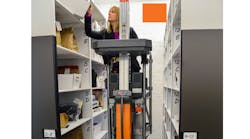Efficient use of storage space isn’t the exclusive domain of industrial warehouses. The police department of the city of Montrose, Colo., needed to improve access to the department’s secure evidence storage. Recently, the police department consolidated its evidence storage into a single location – a renovated historic building originally constructed in 1910 as a fire station.
“The goal was to move everything to one secure location where evidence could be carefully organized, filed and stored, but also be easy for authorized personnel to find and retrieve when they need it,” explained Virgil Turner, director of innovation and citizen engagement for the city of Montrose. Turner’s job description includes responsibility for city facilities, including the renovated fire station, which is adjacent to city hall.
According to Turner, evidence storage is much like a warehouse operation in that it requires significant amounts of shelving. “Shelves are labeled, as are the bins of evidence stored on them, with each bin carefully assigned a particular location on a specific shelf within the storage area.”
Although floor space in the converted fire station is limited, the building’s high ceilings, ranging from 12 to 14 feet, provide plenty of vertical storage for the police department. Taking advantage of this feature, Turner incorporated a high-density mobile storage system to maximize storage space while accommodating the police department’s preponderance of evidence. A mobile storage system replaces static shelves and fixed aisles with shelves mounted on wheels that can be compressed together, eliminating all but one aisle that opens up when and where it is needed by shifting rows of shelving.
Safely storing and accessing evidence on the system’s upper shelves posed a logistical challenge, however.
“We were somewhat constrained by the width of an existing doorway between a load-bearing masonry partition,” said Turner. “We really didn’t want to cut a wider opening if we didn’t have to. Also, once you go through the opening, you have to make an immediate right-hand turn to get into another storage area, which limited the options available to us.”
Turner and his team briefly considered the use of rolling ladders, but found they took up too much floor space, required more room to maneuver than was available, and were too wide to fit through the doorway or make the turn on the other side of the opening.
“We certainly looked at traditional ladders,” he said. “But from a safety standpoint, they bring with them a considerable amount of risk, and they would be difficult to use. Our evidence custodian could not carry large ladders around the storage area, and we did not want to risk injury as she tried to maneuver them around tight corners. Plus, safely climbing a ladder requires three points of contact on the ladder, leaving no way to carry large boxes up or down the ladder.
“So, we knew almost immediately that we would need a lift of some sort. But it wasn’t that simple, because we had a budget constraint. This was not something we thought we would need when original plans for the storage area were considered.”
Turner’s search eventually led him to an aerial work platform (the FS60 LiftPod, from JLG). With a 12-foot working height and a compact 30-inch base, the personal and portable lift offered Turner the dimensions and the maneuverability he needed.
“The platform takes up much less floor space than any other option we considered and fits through the doorway, easily making the turn into the storage area,” said Turner. “Our evidence custodian is able to place a box on the material shelf and then step into the lift and know that she is in a secure cage, which lifts her to the point where she needs to be to safely unload the box or retrieve another.”
The platform holds up to 330 pounds, while the enclosed basket provides the ability to work 360 degrees with both hands.
The work platform consists of three components, each weighing about 50 pounds, for simple assembly, which was of interest to Turner. “It breaks down very quickly, so we can have our maintenance folks break it down, carry it and set it up where they need it. Its weight and size mean we can bypass the 12 steps into another building where we’ve taken it, using the handicap lift on the outside of the building.”
Turner is considering purchasing a second aerial work platform for use in the facilities department.



